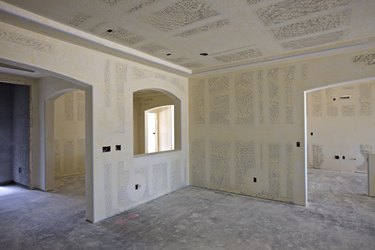
Drywall gives your walls a smooth surface that you can paint or wallpaper to suit your taste. Whether you're adding on to your home, converting a garage or remodeling an existing structure, you'll find that performing construction tasks in a specific order can save time and effort. When you're hanging drywall and installing new flooring, it's usually best to hang the drywall first and then save the floor for last.
Time and Mess
Video of the Day
If time is of the essence, it's quicker to hang the drywall and tape out the walls first. The general construction rule is to work from the top of the room downward. Construction's a messy job, and if you install the flooring first, you'll spend more time on the walls because you'll have to be more careful not to drip joint compound on a new floor. If you must do the floor first, cover it carefully with nonskid drop cloths. Avoid plastic drop cloths, which can become slick and hazardous during the taping process.
Video of the Day
Potential Flooring Damage
Not only is it messy, but bits of crumbled drywall and drippy joint compound can damage existing flooring. If the floor is wood, stepping on a dropped screw can leave a permanent scratch, and cleaning joint compound out of new carpeting isn't a pleasant task. If you install the floor last, however, you can scrape and sweep the debris off the subfloor and then lay your new flooring without worry.
Installation Guides
Drywall installers use the floor as a guide to locate studs and electrical boxes. If the subfloor is bare, the installer will often make pencil marks on the subfloor directly beneath switch boxes or other utility elements. When the wall is taped and sanded, the marks on the subfloor serve as visual guides for locating the elements and cutting the drywall around them. The new flooring will cover up the marks.
Humidity Concerns
Taping drywall seams adds substantially to the humidity in a room. If you're installing hardwood or manufactured hardwood, read the manufacturer's installation instructions. Wood flooring, because it's a natural product, expands and contracts with temperature changes and moisture levels. The manufacturer may recommend a minimum two-week acclimation period after the room is climate-controlled to reduce swelling and warping of the wood.